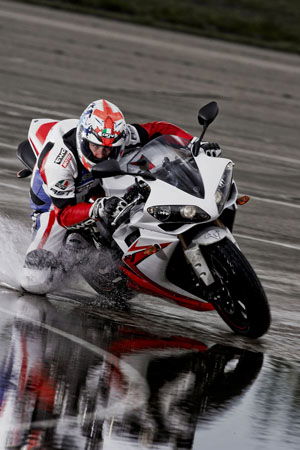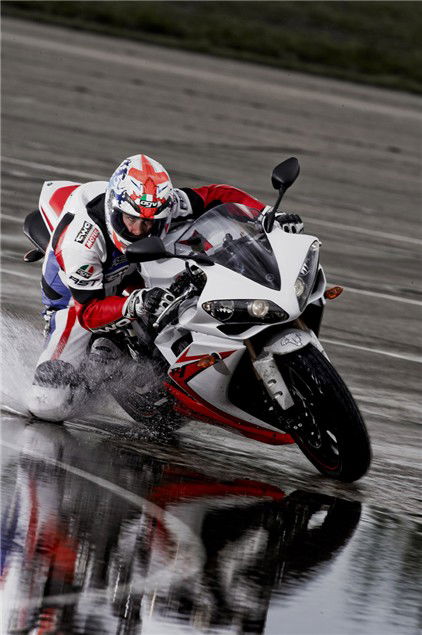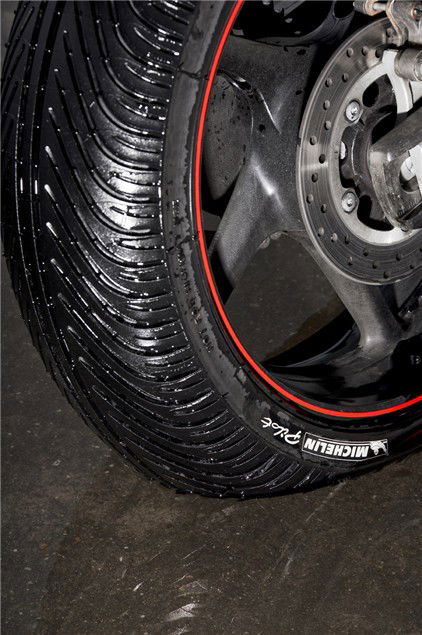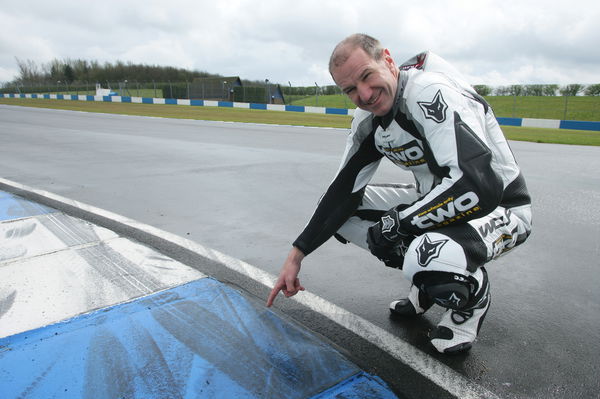Advanced Riding Course: Wet Weather Rain Tips
Advanced riding tips to help you improve your wet weather motorcycle riding skills


|
We've had a bit of breathing space of late, but the truth is that this is the 4th wettest summer ever for Britain, and the wettest on record since records began for England. It's rained since the end of that nice patch back in April, so we figured it was time to give you a quick mid-summer booster guide on how to get the most out of this soggy washout. With the help of James Whitham, who admits that "the only way I used to go fast in the wet was to follow the guy in front of me, and then try to go a bit quicker," read, digest, adjust your tyre pressures accordingly and go for a nuclear ride this weekend.
HOW TO RIDE FAST IN THE WET
Staying smooth is the key. Your braking and throttle openings should be considered and much more gradual than in the dry. This avoids the chances of spinning the rear or losing the front. On the way into corners, brake in a straight line and build up pressure as the front tyre squashes into the road. On the way out, feed throttle in as the bike approaches upright and be prepared for it to spin a little. Where you ride in the road is critical in the wet. You'll find the roughest, grippiest tarmac in the middle of the road where the cars don't wear it down, while slick, shiny stuff is as slippy as ice. Junctions and corners with Shellgrip (the light-coloured tacky stuff) is as grippy as normal tarmac in the dry. If you have to panic-brake, load the front as gradually as you can before piling on the anchors. You'll be amazed what you can get away with. Some people like to drop their tyre pressures by 2-5psi front and rear, but the trade-off is that the bike's handling will be compromised and there is an argument that dropping pressures actually stops the tyre clearing water as effectively.
HOW TO WHEELIE IN THE WET
Exactly the same as wheelying in the dry, but the clutch-up approach is more likely to fail as large lumps of power will cause the back end to break away. Therefore you're better off using power in 1st gear to get the front up. Assuming you know how to wheelie already, click it into 2nd as she rises up as per normal, and keep the rear wheel on the more coarse tarmac. If she starts spinning at the rear, all that will happen is that the front will plonk back down to ground, so overall there's very little drama.
USING WET TYRES ON THE ROAD
Not legal, but the chances of getting a tug for these incredibly grippy, hugely-treaded wet-weather monsters is slim. For our cover shoot we used a set of monsoon-spec Michelins, which allowed James to bury his knee in one-inch of water on sodden ground. The bike feels horrible in the dry, the tyre-blocks move all over the place, and the rear tyre will shred within 400 miles on a big sportsbike if it isn't raining. But no tyre on earth warms up as quickly or gives you as much security in the wet.
AND GETTING YOUR KNEE DOWN
Even with Michelin monsoon tyres fitted, you still need a fair modicum of skill to pull this off. Whitham was circulating for about five minutes to warm the rubber before cutting right into the wet stuff. The front pushed hard several times on overbanding, but the tread blocks of the front tyre are designed to re-grip as they distort. James was hanging right off the bike, but the knee was going down and staying down.
WHY IS THE WEATHER SO EXTREMELY SHIT?
At our whit's end with the weather, we called the Met Office and demanded an explanation. After getting through to BBC TV weatherman John Hammond, we were pounded into submission with science:
"This summer has been dominated by low pressures, and these have been driven over by the Jet Streams that come in from North America at 40,000 feet. Normally these are about 1,000 miles north of us over Iceland and Greenland, but this year they were lower than normal due to the Lanina, a cold current of water that surges through the Pacific. When that reaches the eastern Pacific, as it has this year, it influences the direction of the Jet Stream and you get the situation we've had. We've also been unlucky in that there's been several low-pressure systems anchored out over the Atlantic, which have been swirling around delivering cool, wet weather to the British Isles from the North-West. None of them have been shockingly low, I think the lowest one we've recorded was 994 millibars, but these systems are deep and haven't moved away. People tend to forget that extreme weather is part of Britain's heritage. Last year was the hottest summer ever with just 41mm of rain in July, and this year was the wettest ever with 129mm of rain over the same period. For you bikers, the 1st week of September is probably going to be the best."
With the help of James Whitham, who admits that "the only way I used to go fast in the wet was to follow the guy in front of me, and then try to go a bit quicker," read, digest, adjust your tyre pressures accordingly and go for a nuclear ride this weekend.
How to ride fast ride in the wet
Staying smooth is the key. Your braking and throttle openings should be considered and much more gradual than in the dry. This avoids the chances of spinning the rear or losing the front. On the way into corners, brake in a straight line and build up pressure as the front tyre squashes into the road. On the way out, feed throttle in as the bike approaches upright and be prepared for it to spin a little.
Where you ride in the road is critical in the wet. You'll find the roughest, grippiest tarmac in the middle of the road where the cars don't wear it down, while slick, shiny stuff is as slippy as ice. Junctions and corners with Shellgrip (the light-coloured tacky stuff) is as grippy as normal tarmac in the dry. If you have to panic-brake, load the front as gradually as you can before piling on the anchors.
You'll be amazed what you can get away with. Some people like to drop their tyre pressures by 2-5psi front and rear, but the trade-off is that the bike's handling will be compromised and there is an argument that dropping pressures actually stops the tyre clearing water as effectively.
How to wheelie in the wet
Exactly the same as wheelying in the dry, but the clutch-up approach is more likely to fail as large lumps of power will cause the back end to break away. Therefore you're better off using power in 1st gear to get the front up.
Assuming you know how to wheelie already, click it into 2nd as she rises up as per normal, and keep the rear wheel on the more coarse tarmac. If she starts spinning at the rear, all that will happen is that the front will plonk back down to ground, so overall there's very little drama.
Using race wet tyres on the road
Not legal, but the chances of getting a tug for these incredibly grippy, hugely-treaded wet-weather monsters is slim. For our cover shoot we used a set of monsoon-spec Michelins, which allowed James to bury his knee in one-inch of water on sodden ground.
The bike feels horrible in the dry, the tyre-blocks move all over the place, and the rear tyre will shred within 400 miles on a big sportsbike if it isn't raining. But no tyre on earth warms up as quickly or gives you as much security in the wet.
And getting your knee down
Even with Michelin monsoon tyres fitted, you still need a fair modicum of skill to pull this off. Whitham was circulating for about five minutes to warm the rubber before cutting right into the wet stuff. The front pushed hard several times on overbanding, but the tread blocks of the front tyre are designed to re-grip as they distort. James was hanging right off the bike, but the knee was going down and staying down.













